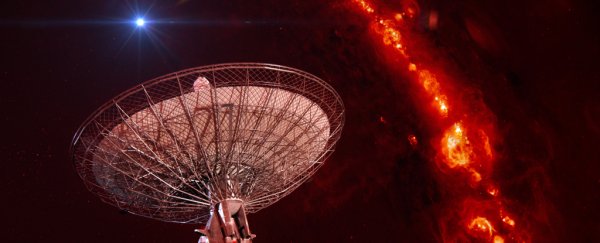Fast radio bursts (FRBs) are explosive space events that have puzzled astronomers for decades - in milliseconds, these bursts generate as much energy as the Sun does in an entire day, but because we so rarely detect them (we've only spotted 17 to date) we pretty much have no idea where they come from.
Now an international team of astronomers has been able to pinpoint for the first time the origin of one of these bursts - and the results provide some important clues about what might be causing them.
The FRB they examined - the not-so-playfully named FRB150418 - was detected on 18 April 2015 by the Parkes radio telescope in Australia. Unlike the 16 radio bursts that had been detected before it, this was the first to be spotted in real time, which meant researchers could immediately jump on its trail.
Within hours, telescopes around the world were studying the burst's radio afterglow - which lasted for around six days before fading away. This combined effort let them pinpoint that the FRB had come from an elliptical galaxy around 6 billion light-years away.
"It's the first time we've been able to identify the host galaxy of an FRB," said lead researcher Evan Keane, who began working on the project while at Swinburne University of Technology in Australia, and is now based at the Square Kilometre Array organisation in the UK.
But radio bursts aren't just interesting in their own right, they're also incredibly useful tools that we can use to measure the Universe.
"The FRB signal encodes how many electrons it has passed through," said one of the researchers, Simon Johnston from Australia's CSIRO. "Essentially this lets us weigh the Universe."
So how does that work? When the radio waves of the burst hit Earth, the higher frequencies arrive before the lower ones, and "the length of the delay allows astronomers to calculate the amount of matter the radio waves have passed through to reach us", Stuart Clark explains for The Guardian.
This has now let the researchers confirm that only 4 percent of the Universe's mass can be found in regular matter, with the rest locked away in dark matter and energy.
And they've also managed to find out where half the atoms in the Universe have been hiding - in clouds between the galaxies.
"This is a solid result. We thought the matter had to be there but it's nice to have actually made a measurement," Keane told Clark.
So what does all this tell us about how FRBs are formed? Until now, it's been proposed that the mysterious bursts could come from all sorts of crazy places, such as:
- pulsars (a special type of dying star, called a neutron star, that's rapidly spinning)
- collapsing neutron stars
- disappearing black holes
- and, yep, alien beacons.
The research suggests we can now cross off that first option, based on the old age of the galaxy that FRB150418 came from.
"Something like a pulsar doesn't live that long, so when you see it, it is young, and not that long since it was born," Keane told Gizmodo. "So as there is low or no star formation happening in the galaxy now it means the source is probably not from a young stellar population."
Instead, the researchers think the FRB probably emanated from the collision of two neutron stars, as they reported in Nature.
As luck would have it, there's only one way to confirm whether this interpretation is correct or not, and that requires the detection of gravitational waves from a similar collision - something we're now able to do using the LIGO observatory.
And while in the past FRBs have been incredibly hard to detect, they're predicted to be happening all over the Universe all of the time, we just need the right equipment to see them… something like the Square Kilometre Array, which should allow us to make FRB spotting a regular occurrence.
It's been a long road up to this point, but we finally have all the tools in place to get answers about these enigmatic events more quickly in future, and that's really exciting.
Swinburne University of Technology is a sponsor of ScienceAlert. Find out more about their innovative research.
